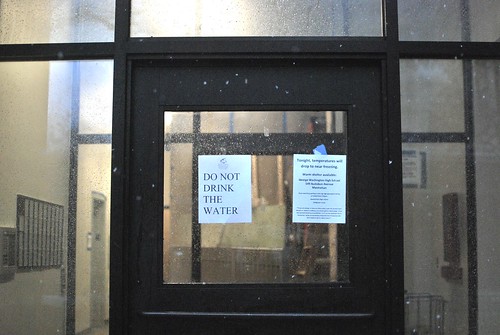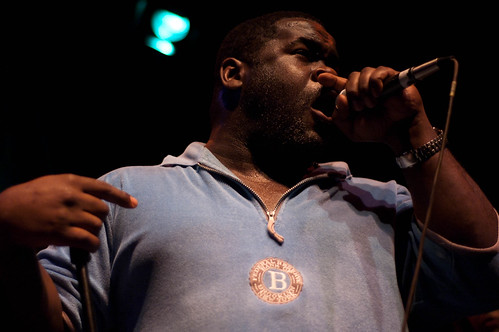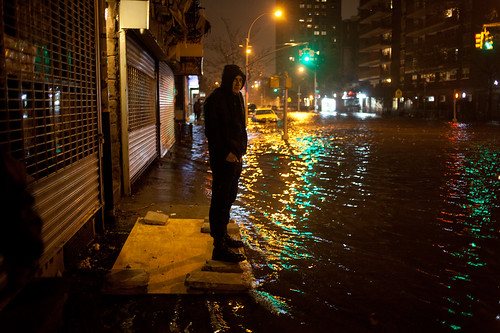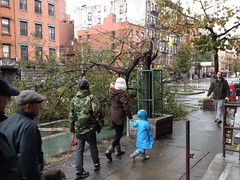A living archive of urban activism, the Museum of Reclaimed Urban Space rented a storefront for its exhibits from C-Squat on Avenue C — and, like neighboring businesses, soon found itself clearing up after Hurricane Sandy.
HURRICANE SANDY
The Bowery Mission Braces for Winter
By ANNA SANDERSAt exactly 4:45 a.m. everyday, Albert Alston flicks on the lights to rouse the men asleep on what passes for a dormitory annex at the Bowery Mission–its chapel floor and pews. “I do it the same way I did it as a platoon sergeant,” he said. “I know I just have to get them up.”
Sometimes the men wake weary-eyed and waspish, but not usually. “Sergeant” Alston’s gruff voice and wide grin are part of a routine they’ve come to expect when sleeping at the Mission this winter, as temperatures drop and it’s become too cold to stay outside.
They turn to the Mission for shelter in extreme weather-induced emergencies, too, as we saw last month, when it became a refuge for many neighborhood residents without power during Hurricane Sandy, as well as when the Nor’easter dropped that thick coat of snow soon after. But even before the storms, the staff was braced for its annual winter increase in homeless patrons, which can mean up to 50 percent more than the usual 700 meals to serve, and twice as many men to lodge.
“The elements can kill them,” Matt Krivich explained. He’s the mission’s director of operations. “We’ve lost a couple of our guests before to hypothermia. That’s why we open up our chapel.” Krivich and the Mission’s other staff–many once homeless themselves–have an open-door policy for anyone seeking shelter from the cold.
When temperatures drop below 40 degrees, the Mission provides regular shelter to 80 men in its residential recovery program and emergency shelter to up to 80 more, making room for 30 in the dining room in addition to the 50-plus it can handle in the chapel. During some snowy weeks last winter, the Mission even allowed community members to sleep in the serving line near the kitchen.
“How can you turn somebody away when you’ve got space?” Krivich said. “If it’s just up on stage, if it’s in the serving line?”
As the chapel usher, Alston helps organize the emergency housing guests, part of the group known here as the “community.” Though other staff caution that the community can be “rough,” Alston gets along with them.
“That’s only because I give them the same respect they give me,” he said.
It might also be because the 56-year-old Alston, soft-spoken with bright eyes, is down on his luck, too. He lost his job at a Canarsie metal yard in September because “they decided to keep all them younger guys.” Shortly after, Alston’s landlord decided to sell his apartment building in Brooklyn. Not wanting to burden his mother, Alston went to a veteran’s organization in the Bedford-Stuyvesant section of Brooklyn looking for a place to live. The organization connected him with the Mission, which had a spot free in their residency program.
Alston’s been here for two months, living in the actual dorm above the chapel. As part of his new job, he shepherds the community into pews for service three times a day before the kitchen opens. Read more…
The Nuyorican Fights the Chill
By KIM DAVISHurricane Sandy wrecked the HVAC system at the Nuyorican Poets Cafe, leaving the storied performance space without heat.
In an email to The Local, executive director Daniel Gallant said that while “relatively warm weather and the use of small space heaters have allowed us to continue running our programs for the past few weeks, it will be difficult for us to remain open as the weather gets colder unless our heating system is replaced.” There are also concerns about burst pipes when the freezing weather finally arrives.
The cost of replacing the system is estimated at $27,500. The Cafe, like other local businesses, also suffered loss of revenue due to the post-hurricane power outage and canceled events. This Thursday’s fund raiser at Joe’s Pub is just part of the recovery effort. Donations are also being taken at the website.
The Day | What’s in a Nog?
By KIM DAVISGood morning, East Village.
In yet another reminder that the clean-up work after Sandy continues, the East Village is set to regain its R train connection with Brooklyn before the holidays. Spare a thought too for the Nuyorican Poets Cafe. After long struggles to renovate the fabric of its old building, its heating system was taken out by the hurricane. It plans to hold a fund raiser at Joe’s Pub on Thursday evening.
The SantaCon backlash just gets worse. Meanwhile, EV Grieve continues to compile a list of impending business closures, including the distinctive (and large) Bargain Express on the south side of East 14th Street, and Whole Earth Bakery on St Mark’s Place.
Finally, to prompt a holiday mood, here’s the Village Voice’s veteran food critic Robert Sietsema on the history of that strange, sweet, sticky stuff, eggnog.
Still Without Power, Haven Plaza Residents Lug Toilet Water Up 20 Flights
By JOANN PAN Joann Pan Signs warn residents: “Do Not Drink the Water.” Cases of bottled water are available to all residents living in Haven Plaza.
Joann Pan Signs warn residents: “Do Not Drink the Water.” Cases of bottled water are available to all residents living in Haven Plaza. For nearly 11 days, Isa Gonzalez and her two young children have been living in the dark, without heat or running water.
To get to their apartment at One Haven Plaza, they climb 17 flights of unlit stairs. The federally subsidized high-rise at Avenue C and 13th Street was one of the many buildings that lost power after Hurricane Sandy hit last Monday.
Electricity started flowing to the apartments in Two and Three Haven Plaza this week, though – like many other buildings in Alphabet City – they are still without heat or water. But at One Haven Plaza, where electrical equipment in the basement was badly damaged by flooding, the situation is worse. Signs reading “Do Not Drink the Water” are posted in the hallways, next to elevators at a standstill.
Daisy Lopez, site manager of the three buildings, believes power may not be restored for a week. “We are telling everyone one week, but we are hoping sooner than that,” she said, wearing a scarf and hat in her unheated office yesterday.
Some of the building’s elderly tenants and families with young children had the option to take a limited number of vacant rooms at the Grand Street Guild housing development, affiliated with the plaza’s management company. But half of the residents remain, Ms. Gonzalez estimated. Read more…
Photos: Sandy Hits the East Village
By KONSTANTIN SERGEYEVWe posted a few cell phone shots of Sandy’s aftermath yesterday. Here now are some proper photographs of the storm and its wake, by photographer and C-Squat resident Konstantin Sergeyev. Stay tuned for this morning’s update.
East Village Weathers the Superstorm
By DANIEL MAUREREast Villagers woke up to waterlogged cars, downed trees, limited cell phone reception, and an acrid smell in the air – a lingering reminder of a circuit-breaker explosion at the Con Edison plant on 14th Street that preceded a blackout affecting nearly all of Manhattan south of 39th Street.
Next to the facility, on 13th Street east of Avenue C, a half dozen people attempted to dry out and jump-start cars that had been underwater hours before, as other vehicles sat in garages where water still stood above tire level. On Avenue C, a Stuy Town resident tended to a Volvo with a smashed window. The man, who did not want to be named, said he had tried to drive the car out of an underground garage after he looked out of his apartment window and saw river water beginning to gush up Avenue C.
Within five to ten minutes, he said, the water was up to mid-thigh level. “I tried to get out of the garage and as soon as I hit the gate it was a wall of water,” he said. When he realized the water had reached his car window, he bailed out and waded through a chest-level “river,” dodging floating vehicles as he tried to get to shallower waters on 14th Street. “Cars were afloat. All I needed was one car to blow me into the wall. It was chaotic,” he said, adding that the scene became “9/11-like” when a circuit-breaker exploded at the Con Ed plant, just a block away, and plunged the neighborhood into darkness around 8:30 p.m. Read more…









